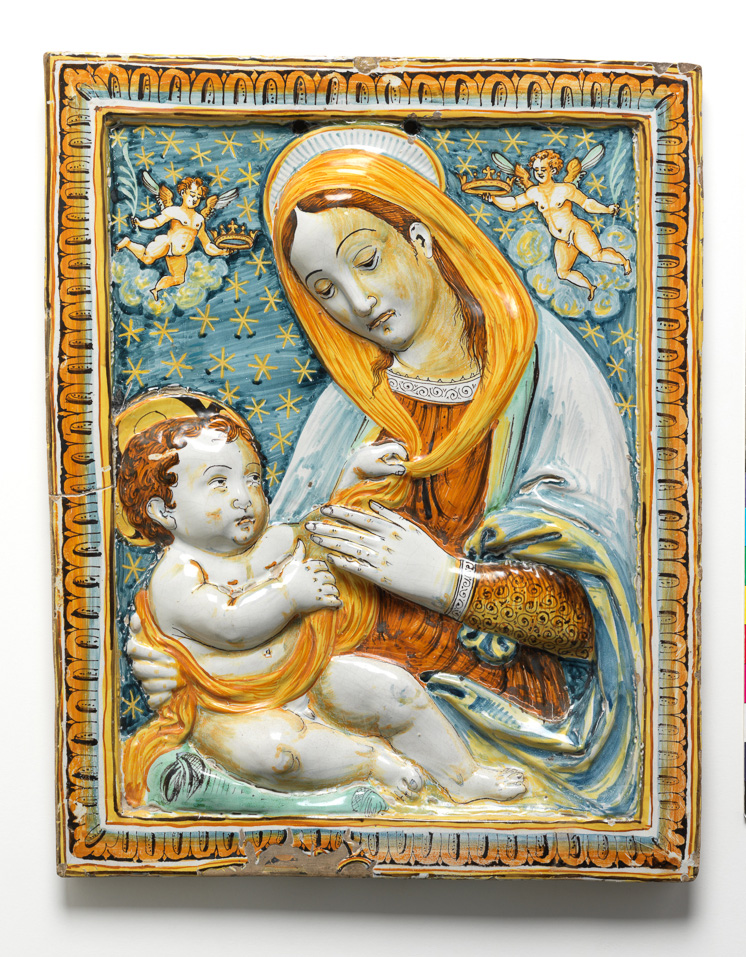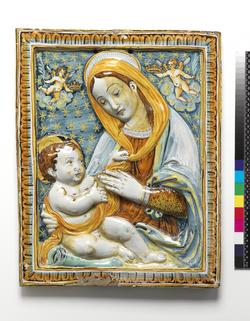Current Location: In storage
Titles
Virgin and Child
Maker(s)
Maker:
Unidentified Deruta potter
Sculptor:
Benedetto da Maiano
(After)
Entities
Categories
Description
Maiolica relief, painted in polychrome with a half-length figure of the Virgin with the infant Christ.
Buff earthenware, moulded in relief and tin-glazed on the front and sides; the reverse unglazed. The glaze has crawled to the left of bottom centre. Painted in watery dark blue, pale blue, yellow, orange, and dark manganese-brown.
Rectangular, with two suspension holes inside the raised frame at top centre.
Within a frame of egg and dart ornament is a half-length figure of the Virgin with the infant Christ sitting on a cushion on her lap. He plays with her veil and she restrains Him with her right hand. On each side of the Virgin's head is a cloud with a cherub flying out of it, holding a crown in the hand nearest to her and a palm in the other. The dark blue background is scattered with stars.
Notes
History note: Acquired before 1902 by Dr J.W.L. Glaisher, Trinity College, Cambridge
Legal notes
Dr J.W.L. Glaisher Bequest
Measurements and weight
Depth: 3 cm
Height: 46.5 cm
Width: 37 cm
Acquisition and important dates
Method of acquisition: Bequeathed
(1928-12-07)
by
Glaisher, J. W. L., Dr
Dating
17th Century
Circa
1600
CE
-
1700
CE
Note
Devotional panels moulded in relief with this representation of the Virgin and Child were been made mainly in Deruta. The image derives from a marble relief attributed to Benedetto da Maiano (1442-97), formerly in the Orléans collection at Bologna and now in the Blumenthal collection in New York. The location of the panel in the sixteenth and seventeenth centuries is not known, and the immediate prototype of the maiolica panels was probably a terracotta or plaster cast.
Label text from the exhibition ‘Madonnas and Miracles: The Holy Home in Renaissance Italy’, on display at The Fitzwilliam Museum from 7 March until 4 June 2017: This rectangular plaque has two holes at the top, suggesting that the image originally hung on a wall. The heavenly colours of blue, gold and white, as well as the starry background and the angels holding crowns, remind the viewer that, according to Catholic tradition, the Virgin was crowned ‘Queen of Heaven’ after her death. The Child is shown entwined in her golden veil.
There are numerous panels of this type, which can be divided into two main groups. The relief moulding of one group, to which this example belongs, follows the iconography of the marble. The other group deviates from it in having a cherub's head in the fold of the drapery under the Virgin's left arm, which may be accompanied by a cherub or angel's head in the background on the right, or both sides, of the Virgin's head, sometimes obscured by the painted background. This group appears to be related to a painted plaster relief also attributed to Benedetto da Maiano in the Skulpurengalerie, Staatliche Museen Preussischer Kulturbesitz, Berlin. This has three cherub's heads, and is approximately the same size as the maiolica panels, 49.5 x 39 cm. A tondo, without cherub's heads, is in the Palazzo di Venezia, Rome (PV5480). The painted backgrounds of both groups of maiolica reliefs include draped curtains, draped curtains with a window on the left, a wall with or without drapes, and a landscape with buildings. The number of moulds used suggests that production continued over a long period, probably throughout the seventeenth century. The only dated example cited is at the Bowes Museum, Barnard Castle (X 1559). This belongs to the second group, and differs from most of the others in having a panel at the bottom bearing two coats of arms, and an inscription giving the date 25 February 1633. Somewhat similar panels, presumably inspired by an Italian example, were made at Triana, Seville.
School or Style
Renaissance
People, subjects and objects depicted
Components of the work
Decoration
composed of
high-temperature colours
( watery dark blue, pale blue, yellow, orange, and dark manganese-brown)
Front And Sides
composed of
tin-glaze
Materials used in production
Earthenware
Techniques used in production
Moulding in relief
: Buff earthenware, moulded in relief and tin-glazed on the front and sides; the reverse unglazed. The glaze has crawled to the left of bottom centre. Painted in watery dark blue, pale blue, yellow, orange, and dark manganese-brown.
References and bibliographic entries
Related exhibitions
Identification numbers
Accession number: C.2200-1928
Primary reference Number: 73227
Old object number: 1342
Stable URI
Audit data
Created: Saturday 6 August 2011
Updated: Tuesday 20 August 2024
Last processed: Tuesday 15 July 2025
Associated departments & institutions
Owner or interested party:
The Fitzwilliam Museum
Associated department:
Applied Arts

 IIIF Manifest
IIIF Manifest







